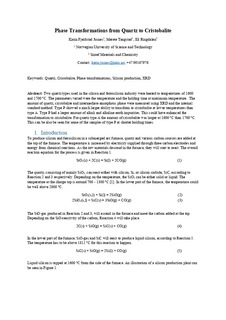| dc.contributor.author | Jusnes, Karin Fjeldstad | |
| dc.contributor.author | Tangstad, Merete | |
| dc.contributor.author | Ringdalen, Eli | |
| dc.date.accessioned | 2019-05-29T07:22:49Z | |
| dc.date.available | 2019-05-29T07:22:49Z | |
| dc.date.created | 2018-11-30T15:32:31Z | |
| dc.date.issued | 2018 | |
| dc.identifier.isbn | 978-3-319-95021-1 | |
| dc.identifier.uri | http://hdl.handle.net/11250/2599349 | |
| dc.description.abstract | Two quartz types used in the silicon and ferrosilicon industry were heated to temperatures of 1600 and 1700 °C. The parameters varied were the temperature and the holding time at maximum temperature. The amount of quartz, cristobalite and intermediate amorphous phase were measured using XRD and the internal standard method. Type P showed a much larger ability to transform to cristobalite at lower temperatures than type A. Type P had a larger amount of alkali and alkaline earth impurities. This could have enhanced the transformation to cristobalite. For quartz type A the amount of cristobalite was larger at 1600 °C than 1700 °C. This can also be seen for some of the samples of type P at shorter holding times. | nb_NO |
| dc.language.iso | eng | nb_NO |
| dc.publisher | Springer, Cham | nb_NO |
| dc.relation.ispartof | Extraction 2018- Proceedings of the First Global Conference on Extractive Metallurgy | |
| dc.relation.ispartofseries | The Minerals, Metals & Materials Series; | |
| dc.subject | Quartz, Cristobalite, Phase transformations, Silicon production, XRD | nb_NO |
| dc.title | Phase Transformations from Quartz to Cristobalite | nb_NO |
| dc.type | Chapter | nb_NO |
| dc.description.version | acceptedVersion | nb_NO |
| dc.source.pagenumber | 717-727 | nb_NO |
| dc.identifier.doi | 10.1007/978-3-319-95022-8_56 | |
| dc.identifier.cristin | 1637733 | |
| dc.relation.project | Norges forskningsråd: 256788 | nb_NO |
| dc.description.localcode | Publisher embargo applies until August 19, 2019 | nb_NO |
| cristin.unitcode | 194,66,35,0 | |
| cristin.unitname | Institutt for materialteknologi | |
| cristin.ispublished | true | |
| cristin.fulltext | preprint | |
| cristin.qualitycode | 1 | |
